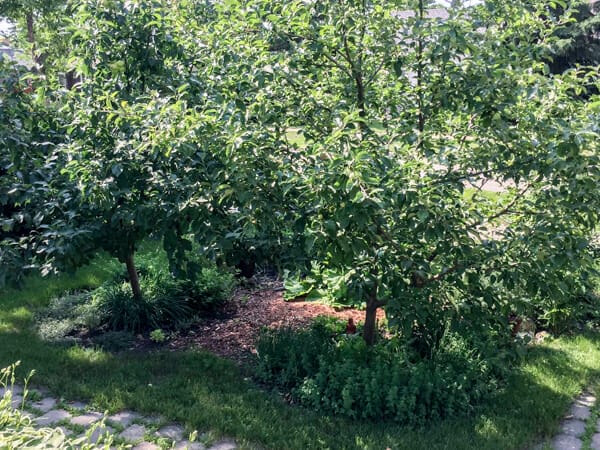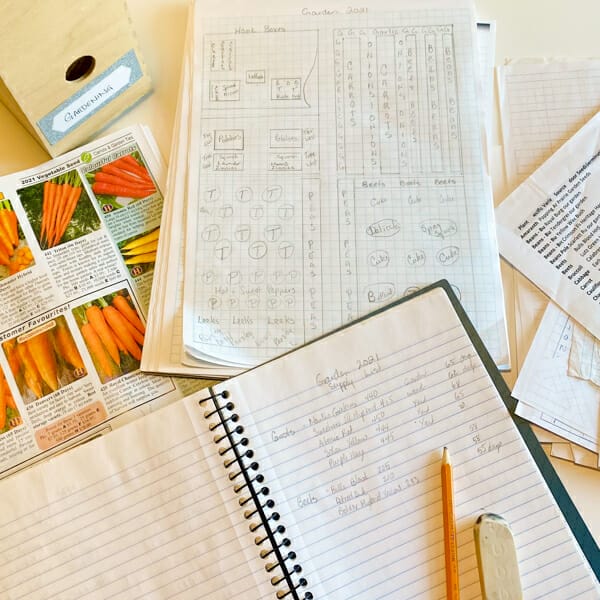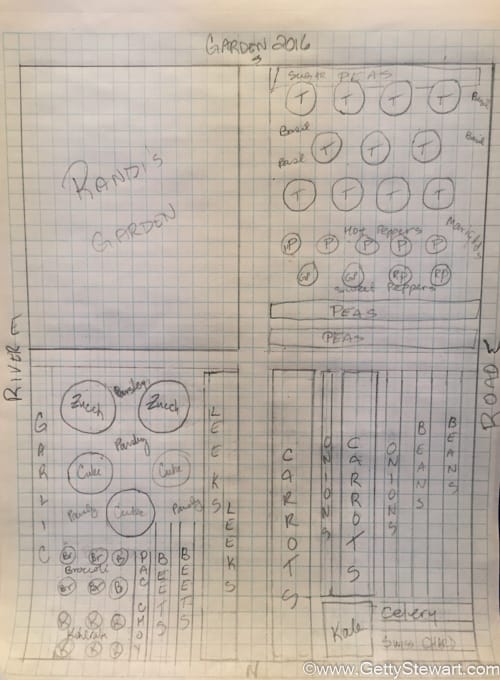How to Make A Gardening Plan for Your Veggie Garden
Every year I make a gardening plan for my vegetable garden. Even though I’ve been gardening since forever, I know it’s a great way to get my head in the game and ensure the best harvest.

I’ve got my seeds, charts, catalogs, pencil, eraser and cup of coffee! Based on my answers re the Six Questions Prior to Planning a Garden, how things went last year, and how the typical harvest time of veggies coincides with my schedule, I get to work roughly drawing out what I want to plant where.
I literally make a gardening plan or drawing representing what to plant where. That way, I’ll know what and how many seeds or transplants I need. The first time I drew out the plan, I did it on graph paper and so I could do it somewhat to scale. I didn’t measure exactly, but I wanted a rough idea of how much space everything would take. Now I use that same template, year after year.
Once I have a list of what I want to plant and have drawn it out, I go through my box of seeds to see what I have, what I need and what needs to be tossed. Seeds have an expiration date, so you can’t keep them forever. You can always do a seed germination test so you don’t risk losing out on your favorite veggie because of bad seeds.
Then I check out local seed catalogues or go to my local greenhouses and get what I need in time for indoor seed starting or planting outside. There are many great local greenhouses and seed companies to choose from. The most important thing is to choose a place that sells seeds and can offer advice for your local conditions. Unless of course your buying specialty varieties from a specialty seed company and you know what you’re doing!
What to Consider When You Make a Gardening Plan
Sunlight
The majority of vegetables NEED (not just like) sunlight and plenty of it (seed packets will tell you how much). My backyard has dappled shade, there are a few spots that get more sun than others. I have tried and tried growing veggies in every conceivable spot. Sure, I get some growth – but it’s never great and usually pretty disappointing. I didn’t fully appreciate the difference full sun made until I started renting a garden plot that gets full sun. Big difference! So the lesson is look at the seed pack and take the sun recommendations seriously – plant where you have sun.
Yes, there are some vegetables that tolerate some shade. Typically these are greens and root crops. Anything that produces fruit (tomatoes, cukes, squash, beans, etc.) isn’t great without full sun. Expect shade tolerant veggies to take a little longer to grow, produce less quantity and be slightly smaller.
Your best bet in your shady spots are:
Greens: arugula, Bok choy, mustard greens, kale, swiss chard, collard greens, lettuce, mesclun mix, spinach
Herbs: chives, cilantro, garlic chives, mint, oregano , lemon balm, parsley
Root Veggies: carrots, potatoes, beets, radishes, turnips

Spacing
Be sure to leave enough room for your veggies to grow into adulthood. I find this very difficult – a winter squash seed or transplant doesn’t look like it’s going to need 3-5 feet of space – but it really does. And bush tomatoes really do get bushy – give them the recommended space (I tell myself!). Follow the seed instructions or the guidelines in the Planting Chart re spacing. If you’re concerned about blank spots in the garden until the plants fill in, consider planting some early crops like spinach, lettuce, radishes, herbs or flowers beside these plants.
Crop Rotation
Rotating your veggies (planting different veggies in different spots every year) helps minimize pests and disease. It also helps to manage your soil better as some crops are heavier feeders than others and some, like legumes, actually add nitrogen back into the soil.
Our plot is 30′ x 40′. I have divided it into four segments so we can walk around easily and plan for crop rotation. Basically, I just move all the same things from one quadrant into the next quadrant. In 4 years, the zucchini and pumpkins will be back in the same quadrant.
Here’s my garden plan for 2021 – it looks a lot like the one from 2016, just slightly shifted. Note, Randi still gets her quarter, I just added my front yard boxes to the page so I can see everything on one page.

Companion Planting
Did you know planting onions next to carrots can help control the carrot fly, that rosemary repels the cabbage fly or that pole beans and beets planted next to each other will stunt each others’ growth? It might seem crazy at first glance, but it makes sense that nature created natural ways to control and manage life. All we need to do is learn from it and respect it. As much as possible, I plan according to which plants like to be beside each other and which don’t, eg. borage and cucumbers love each other while beans and onions do not. This is how I decided which plants go in which quadrant.
A google search on Companion Planting will provide you with more than enough information on which plants go together and which don’t. Here’s a Companion Planting Chart from the Old Farmer’s Almanac that’s easy and straight forward. One day I will compile a list for our common prairie veggies – but today is not that day – sorry!
This was my garden plan for 2016. By the time I end up digging in the garden, things changed a little, but for the most part it all came true!

That’s how I plan my garden. It is by no means the only or best way to do it and there are other factors I should be taking into consideration – but it works for me. I’m happy with the results I get and I can add on a little more to the plan ever year. I hope it helps you, at least a little.
Will you be planting a garden this year? Will you make a gardening plan or are you more of a risk taker? What’s your favorite veggie?

